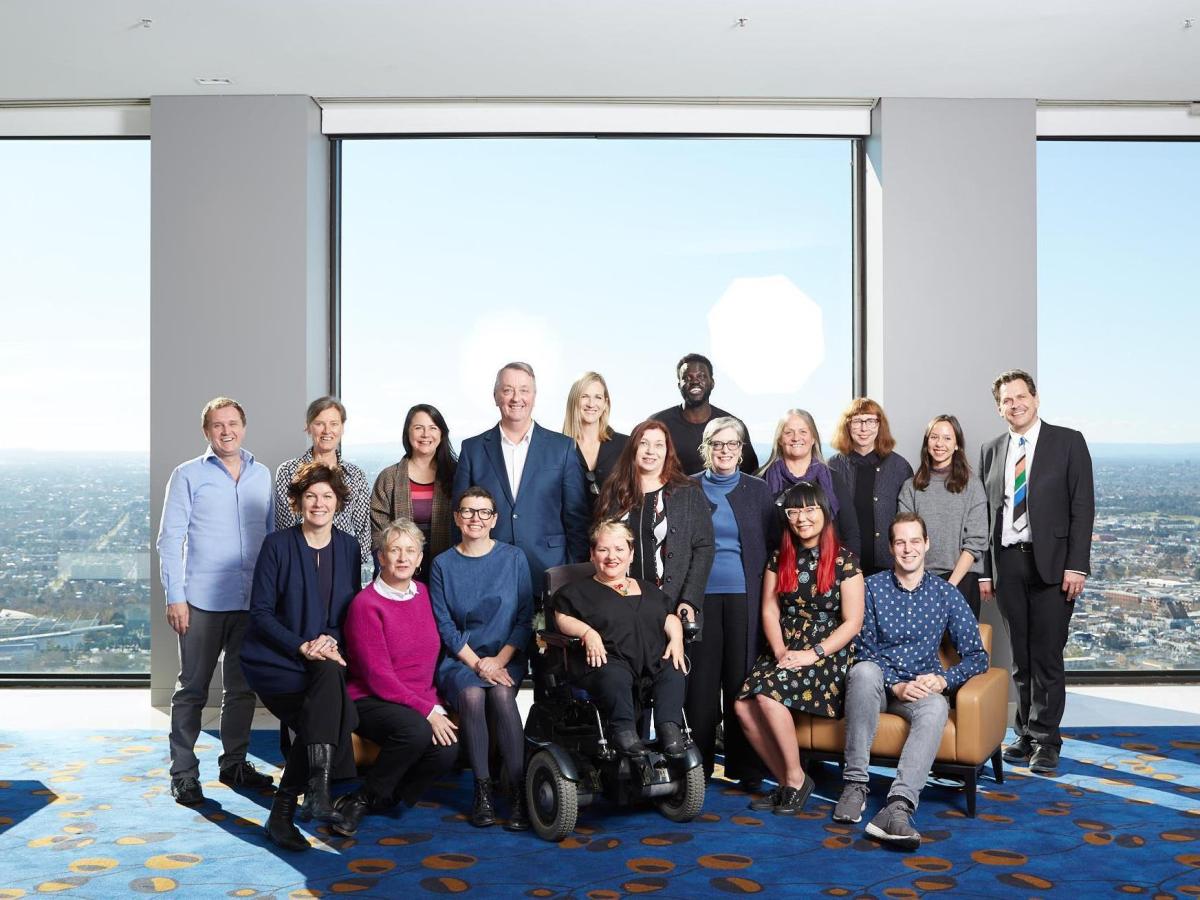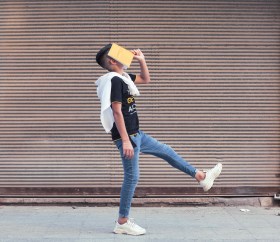Victoria’s Creative Industries Advisory Group. Back row left to right: Ross Symons, Rosalind Crisp, Helen Marcou, Minister for Creative Industries Martin Foley, Lisa Barron, Treahna Hamm, Abe Nouk, Alison Croggon, Vicki Couzens, Fiona Tuomy, Lana Nguyen and Martyn Hook. Front row (sitting) left to right: Nicole Beyer, Angharad Wynne-Jones, Katrina Sedgwick, Caroline Bowditch, Lisy Kane and Peter Tullin. Absent: Adam Briggs, Erin Castellas and Russel Howcroft. Photographer: Daniel Mahon.
A lot can change in four years. Since Victoria’s landmark Creative State strategy was released in 2016 we’ve seen some improvements in diversity and access, technology pulling artforms in directions that once seemed impossible, and witnessed Australian artists connect with new global audiences, in new ways. We’ve also seen affordability become a growing concern for many, a worrying prevalence of mental health issues among creative workers and the Me Too movement has created a wave of change that continues today.
These are just some of the issues, trends and opportunities being considered as the Victorian Government commences work on its next creative industries strategy, looking ahead to 2020-2024. Like Creative State before it, the new strategy will be developed hand in hand with the sector, and anyone interested in the future of Victoria’s creative and cultural life is invited to be part of it.
BRINGING DIVERSE VOICES TO THE TABLE
The process kicked off with the appointment of the Creative Industries Advisory Group, consisting of 20 artists and creative sector workers. Writer/filmmaker Fiona Tuomy was appointed to the group, and is passionate about advocating for all Victorians.
‘They didn’t want the usual suspects on the advisory group, because things are happening very differently in the world now as we try to be inclusive and have marginalised voices from various communities,’ Tuomy told ArtsHub.
Tuomy has been an active advocate through her work as mentor-in-residence as part of Writers Victoria’s Writeability program (working with writers with disability) and as Artistic Director with The Other Film Festival (Australia’s first international disability film festival). Tuomy brings all of these experiences to the advisory group but also wants to engage beyond them.
‘This is a co-design process so it is about making sure you’re working with the communities and honouring those voices. It’s a way of getting the whole of Victoria involved rather than from one institution and saying they make up the arts,’ Tuomy said.
One of the biggest changes she’s seen as a filmmaker is a convergence of artforms as screen culture becomes more central to all artistic fields. ‘Writers and artists and filmmakers – especially in the emerging sector – are really leading that change to cross-genre, and I’m interested in how we capture that in our policy because what we do now sets us up not just for five years but for the next 20.’
BREAKING DOWN BARRIERS
Speaking for diverse communities, and advocating for ways to meaningfully include diverse voices, is something fellow advisory board member Abe Nouk feels passionate about.
A Sudanese-born poet who arrived in Australia in 2004 unable to read or write, Nouk is particularly interested in how people who may not be able to communicate in English can apply for grants. ‘There are talented people whose English language skills are not up to those of other people’s so they think “What’s the point?”. That’s a barrier that needs to be addressed so everyone has the opportunity to present and have a chance to apply for those grants,’ Nouk said.
Nouk believes that rather than an online form which privileges artists who work well in English, a presentation or other way of describing a project would be more effective. This would be particularly true for works that are more visual or conceptual, along with submissions from culturally and linguistically diverse artists where ‘a form is not the best way to communicate a project’.
HAVING YOUR SAY
The advisory group is just one of several ways Creative Victoria is gathering opinions and ideas from the sector. One of the easiest ways to ensure your voice is heard in the process is to make a Post-it note style submission on the Creative State 2020+ website, with short ideas of 140 characters.
A recent submission from contributor MargotWith-a-T echoed Nouk’s idea with a suggestion that we should be: ‘Moving away from a funding model that supports whoever can write the most elaborate proposal to recognising the most creative applicants.’
Another advisory group member, ad-man Russel Howcroft took to the Ideas Wall to suggest a national Creativity Commission. Other contributions include better representation for regional and Indigenous artists, and councils opening up untenanted spaces to host artists and their work.
Of course some ideas need more detail than a tweet, so there’s also the opportunity to contribute to a discussion thread on one, or more, themes or upload a longer submission. Submissions can be made either in written form or as a video explaining your idea. There is also a series of public forums in locations ranging from Mildura to Bendigo to Frankston. And if there isn’t a forum nearby, organisations or groups are encouraged to run their own consultation session.
Advisory board members are keen to be involved with the forums to spark more conversations. Tuomy said of the public consultation process: ‘I’m going to try to attend as many sessions as possible – because it’s not just about me and my opinion but how much I can listen to others.’
Nouk would similarly like to hear from people outside his own networks. ‘I personally have to put aside my own complaints and think of people who aren’t in this advisory group. I have to voice the frustrations that communities go through.’
Tuomy agrees that getting involved is key to change. ‘By participating you are making a contribution to help transform the centre. If everyone is at the centre then no-one feels marginalised,’ she told ArtsHub.
Nouk added his encouragement to anyone thinking about getting involved in defining Victoria’s creative future, ‘Regardless of how small your contribution might be, this is a necessity. If they don’t do their part then they are doing a disservice to the younger people who might not be able to participate in this process.’
To help shape Victoria’s future creative industries strategy, have your say at the Creative State 2020 website before 30 August 2019.






